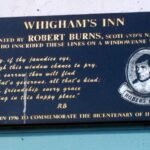Before the first tee is swung at the new Old Petty Championship Golf Course in the Scottish Highlands, archeologists made a swing of their own—straight into the ancient past.
Excavations ahead of construction uncovered a 2,200-year-old Iron Age chariot wheel, the first of its kind ever discovered in the Highlands and only the fifth confirmed chariot artifact in all of Scotland. The remarkably preserved iron wheel was found inside a prehistoric ceremonial enclosure, alongside a trove of artifacts spanning the Bronze Age, Neolithic, and Iron Age.
And at first, no one believed it was real.
“We were a bit bemused.”
That was the reaction of Andy Young, principal archeologist at Avon Archeology, who led the excavation team.
“I was initially a bit dismissive,” Young admitted to BBC News. “None of us had really seen one before in terms of physically excavating one. We were a bit bemused.”
The site had initially been flagged during preliminary surveys, but no one expected a rare ceremonial chariot burial to emerge just beneath the grassy knolls of the future golf resort.
What was first assumed to be a modern farming wheel turned out to be an intricate, forged iron artifact that could only have been crafted by a master blacksmith. According to experts, its creation involved forge-welding multiple smelted iron strips, heating them into a tire, and shrinking it over a wooden frame—a level of craftsmanship far ahead of its time.

Inside the pit: fire, iron, and memory
The wheel was found inside a palisaded enclosure, possibly a ritual circle, near the planned fairways of the Cabot-owned Old Petty course. It was buried with cremated human remains, coarse pottery, animal bones, and other items suggesting a votive or high-status burial—possibly even a tribal chief.
In addition to the wheel, archeologists uncovered:
-
A 3,500-year-old Bronze Age cremation urn
-
Quern stones used for grinding grain
-
Flint tools
-
Remains of at least 25 Neolithic wooden buildings
-
An ancient corn dryer structure
Taken together, the finds indicate that the site was a long-standing ceremonial and domestic area, used by multiple generations across more than four millennia.
Rare and rooted in ritual
Scotland has only produced four other confirmed chariot-related artifacts to date, making this discovery especially significant. It’s the first chariot wheel ever discovered in the Highlands, adding a new layer to what was previously thought about Iron Age settlement patterns in the region.
Timeline of Scottish chariot discoveries:
| Year | Location | Find |
|---|---|---|
| 2001 | Newbridge, Edinburgh | Iron Age chariot burial |
| 2008 | 40 miles from Newbridge | Horse harness fragment |
| 2025 | Old Petty, Highlands | Full iron chariot wheel |
The presence of the chariot wheel alongside human remains suggests an elaborate ritual burial. Archeologists believe it symbolised a final journey into the afterlife—chariots often served symbolic purposes as much as military or transportation functions.
“They are such a rare thing,” Young noted. “This find offers a new window into Iron Age beliefs, status, and technology.”
Golf course meets ancient past
The discovery was made during pre-construction work on the Old Petty Championship Golf Course, a prestige development by international golf resort operator Cabot.
“It’s humbling to think that Old Petty will rest on such historically rich ground,” said Stuart McColm, VP of Golf Development at Cabot. “We’re proud to be stewards of such a unique site.”
According to Scottish law, developers are required to fund archeological investigations in historically sensitive areas. Cabot has reportedly worked closely with local councils, archeologists, and museum officials to ensure proper handling of the site.
The ceremonial circle has since been reburied at its original location to protect its long-term integrity, and all artifacts will be transferred to museums in Edinburgh and Inverness after analysis.
From battlefield to fairway
The juxtaposition of a modern championship golf course with a prehistoric Iron Age burial is not lost on the archeological community.
For centuries, Scotland’s Highlands have been viewed as remote, sparsely populated, and somewhat disconnected from the cultural pulse of ancient Britain. But discoveries like this are reshaping the narrative, revealing that the region was not only inhabited but also home to skilled metalworkers, ceremonial sites, and complex burial traditions.
This latest find reaffirms a long-held belief in archeological circles: that the Highlands have been ritual landscapes for thousands of years, with farming, ceremony, and craftsmanship persisting from the Neolithic through the Middle Ages with surprising continuity.
What comes next
-
Radiocarbon dating is currently underway for both the cremated remains and surrounding organic materials.
-
A full excavation report is expected later this year, likely coinciding with the course’s public opening.
-
The wheel and associated artifacts will be conserved and placed on display at the National Museum of Scotland and the Inverness Museum & Art Gallery.
While the exact identity of the interred individual may never be known, the richness of the burial hints at a person of considerable social importance—possibly a warrior, leader, or ritual figure whose memory endured for generations.
Today, their resting place will host a very different kind of ceremony: the swing of clubs and the hush of fairways. But beneath it all, a wheel turns still.


















